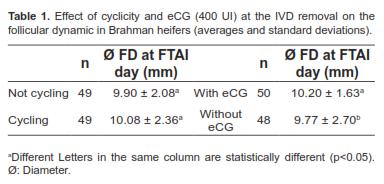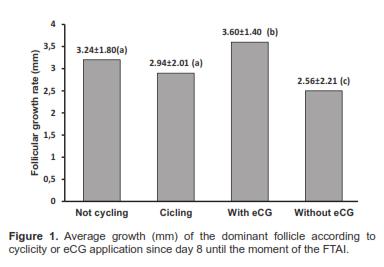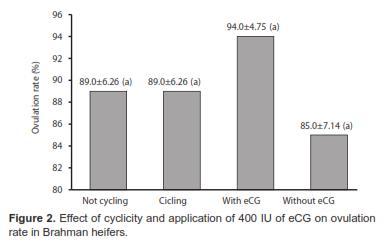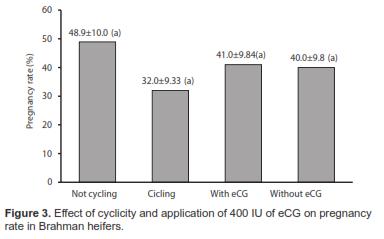Serviços Personalizados
Journal
Artigo
Indicadores
-
 Citado por SciELO
Citado por SciELO -
 Acessos
Acessos
Links relacionados
-
 Citado por Google
Citado por Google -
 Similares em
SciELO
Similares em
SciELO -
 Similares em Google
Similares em Google
Compartilhar
Revista Colombiana de Ciencias Pecuarias
versão impressa ISSN 0120-0690
Rev Colom Cienc Pecua vol.26 no.1 Medellín jan./mar. 2013
ORIGINALS ARTICLES
Effect of cyclicity and Equine Chorionic Gonadotropin (eCG) in fixed-time artificial insemination programs in Bos indicus cattle¤
Efecto de la ciclicidad y la eCG en programas de inseminación artificial a tiempo fijo en ganado Bos indicus
Efeito da eCG e a ciclicidade em programas de inseminação artificial em tempo fixo em gado Bos indicus
Roger D Salgado1*, MVZ, MSc; Libardo A Maza1, MVZ, MSc; Oscar D Vergara1, Zoot, Dr Sc.
* Corresponding author: Roger D Salgado. University of Cordoba. Berastegui campus, Faculty of Veterinary Medecine and Husbandry, Animal Reproduction Laboratory. P.O. Box 354. Montería, Colombia. E-mail: rodasaot@yahoo.es
1 Grupo de Investigación en Producción Animal, Departamento de Ciencias Pecuarias, Facultad de Medicina Veterinaria y Zootecnia, Universidad de Córdoba, AA 354, Monteria, Colombia.
(Received: November 3, 2011; accepted: April 23, 2012)
Summary
Background: fixed-time artificial insemination programs (FTAI) in Bos indicus heifers have low pregnancy rates. Objective: the aim of this study was to evaluate the effect of cyclicity and equine chorionic gonadotropin (eCG) treatment in fixed-time artificial insemination (FTAI) programs in Bos indicus cattle. Methods: a total of 100 heifers were assigned to four treatments using a completely randomized design with a 2 x 2 factorial arrangement, where one of the factors was ovarian status (cyclic or acyclic) and the other was eCG use (with and without eCG). Follicular growth, ovulation, and pregnancy rates were evaluated using analysis of variance or X2 test. Results: no effect (p>0.05) of cyclicity on follicular diameter was observed while eCG showed a significant effect (p<0.05). Cyclicity status and eCG use had no significant effect (p>0.05) on ovulation or pregnancy rates. Conclusions: the eCG application at the time of intravaginal device (IVD) withdrawal increased the size of the ovulatory follicle on insemination day. However, the ovarian state and the use of eCG did not affect ovulation and pregnancy rates of the heifers.
Key words: follicular growth, heifers, ovulation, pregnancy.
Resumen
Antecedentes: los programas de inseminación artificial a tiempo fijo en novillas Bos indicus presentan bajas tasas de preñez. Objetivo: el objetivo de esta investigación fue evaluar el efecto de la ciclicidad y de la hormona gonadotropina coriónica equina (eCG) en programas de inseminación artificial a tiempo fijo (IATF) en ganado Bos indicus. Métodos: se utilizaron 100 novillas y se conformaron cuatro tratamientos utilizando un diseño completamente aleatorizado, con arreglo factorial 2 x 2 con dos categorías, según el estado ovárico (cíclicas y acíclicas) y la utilización de eCG (con y sin eCG). El crecimiento folicular, tasas de ovulación y de preñez se analizaron a través de análisis de varianza. Resultados: no se presentó efecto significativo (p>0,05) de la ciclicidad sobre el diámetro folicular; mientras que la eCG sí presentó efecto significativo (p<0,05). La ciclicidad y la aplicación de eCG no tuvieron efecto significativo (p>0,05) sobre las tasas de ovulación y de preñez. Conclusiones: la aplicación de eCG al momento de retirar el dispositivo intravaginal (DIV), aumentó el tamaño del folículo ovulatorio el día de la inseminación; sin embargo, el estado ovárico y el uso de eCG no afectaron las tasas de ovulación y de preñez en las novillas del presente estudio.
Palabras clave: crecimiento folicular, novillas, ovulación, preñez.
Resumo
Antecedentes: os programas de inseminação artificial em tempo fixo feitos em novilhas Bos indicus apresentam baixa taxa de prenhez. Objetivo: o objetivo desta pesquisa foi avaliar o efeito da ciclicidade e da gonadotrofina coriônica equina (eCG) em programas de inseminação artificial em tempo fixo (IATF) em gado Bos indicus . Métodos: utilizaram-se 100 novilhas divididas em quatro tratamentos utilizando um delineamento inteiramente casualizado com arranjo fatorial 2 x 2 com duas categorias de acordo como o status ovariano (cíclico e acíclico) e o uso de eCG (com e sem eCG). O crescimento folicular, a taxa de ovulação e a taxa de prenhez analizaram-se usando análise de variância. Resultados: não houve efeito significativo (p>0,05) da ciclicidade sobre o diâmetro folicular, en quanto que a eCG apresentou efeito significativo (p <0,05). A ciclicidade e a aplicação de eCG não tiveram efeito significativo (p> 0,05) sobre a taxas de ovulação e prenhez. Conclusões: a aplicação de eCG no momento da remoção do dispositivo intravaginal (DIV), aumentou o tamanho do folículo ovulatório no dia da inseminação, embora, o status do ovário e o uso de eCG não afetaram as taxas de ovulação e prenhez nas novilhas avaliadas nesta pesquisa.
Palavras chave: crescimento folicular, novilhas, ovulação, prenhez.
Introduction
There are two main methods used to synchronize estrogen levels in bovines: by shortening the luteal phase through the use of luteolytic agents such as PGF2α, or artificially expanding the corpus luteum life through progestagen (Richardson et al., 2002). Besides changing the sensibility to progesterone and estrogen in the central nervous system, recent research suggests that manipulating and synchronizing the follicular growth wave is also required (Garcia et al., 2004). Therefore, the use of equine chorionic gonadotropin (eCG) at the end of the treatment is a proposed alternative to synchronize ovulation (Baruselli et al., 2004). The eCG is a glycoprotein characterized by a long halflife. It has a similar effect to FSH and can be used to stimulate follicular growth in cattle (Murphy and Martinuk, 1991; Yavas and Walton, 2000).
Regarding the use of eCG in Bos indicus heifers, significant differences have been reported in favor of using eCG, which is probably associated with the presence of prepubertal animals (Williams et al., 2002). Following the above, the aim of this study was to evaluate the effect of cyclicity and eCG on follicular dynamic, ovulation, and pregnancy rate of Bos indicus heifers under fixed-time artificial insemination (FTAI) programs.
Materials and Methods
Location
This study was conducted in La Macarena Farm (Tierra Alta municipality, Córdoba province, Colombia), located at 8°18' N and 76°04' W, at 52 m above sea level, with an annual average temperature of 28 °C, and 1680 mm annual precipitation.
Animals
A total of 150 Brahman heifers were evaluated. From these animals, 100 were selected with a 3.5 corporal condition score (1 to 5 scale). These animals weighed more than 350 kg and were clinically healthy with a normal reproductive tract and proper development of uterine horns.
The presence of a corpus luteum or a follicle greater than 10 mm was used to classify the ovarian status. Ovaries were evaluated by two 12-day interval tests using a 7.5 MHz ALOKA SSD 500 ultrasound and lineal transducer (Hitachi Aloka Medical, Ltd, Tokyo, Japan). Animals with a corpus luteum and follicle smaller than 10 mm or absence thereof were classified as acyclic and those diagnosed with corpus luteum and follicle greater than 10 mm were considered as cyclic.
Treatments
A completely randomized design in a 2 x 2 factorial arrangement was used in which one factor was ovarian state (cyclic or acyclic) and the other was the use or non-use of eCG. Twenty five heifers were included in each treatment (T), which were randomly assigned to groups according to the following combinations: T1 (Cyclic heifer with eCG); T2 (Cyclic heifer without eCG); T3 (Acyclic heifer with eCG); T4 (Acyclic heifer without eCG).
FTAI Protocol
All heifers underwent the following FTAI protocol. Day 0: introduction of an intra-vaginal device (IVD) containing 1 g progesterone, and 2 mg estradiol benzoate (EB) injection. Day 8: removal of the IVD plus application of 150 µg (D+) cloprostenol and application of 400 IU of eCG (Novormon, Syntex, Argentina) according to the treatment group. Day 9: intramuscular injection of 1 mg of EB. Day 10: artificial insemination 30 hours after the EB.
Data collection
Follicular size was assessed for the presence of corpus luteum by reproductive ultrasonography on day 8 after removing the IVD, and 3 days after artificial insemination. The pregnancy rate was evaluated 45 days post-insemination.
Statistical analysis
Data were analyzed with InfoStat Sotfware (2008) using the following statistic model:
Yijk= u + Tj + Bj + (TB)ij + Eijk
Where:
Yijk: k-th observed value in the j-th level of cyclicity and i-th level of eCG.
μ: overall average.
Ti: effect of i-th level of eCG.
Bj: effect of j-th level of cyclicity.
(TB)ij: interaction of i-th level of eCG with the j-th level of cyclicity.
Eij: random error associated with each observation.
Results
Effect of cyclicity and eCG on the follicular dynamic in Brahman heifers
Statistical analysis showed no significant effect (p>0.05) for the interaction of the factors under study. For this reason, the factors were analyzed separately. The cyclicity effect was not significant (p>0.05) for follicular growth on the day of the FTAI, while application of 400 UI of eCG on the FTAI day had a significant effect over follicular growth in the heifers (p<0.05) (Table 1).
The ovarian function (cycling and not cycling) at the start of treatment showed that this had no significant effect (p>0.05) on follicular growth rate at the day of FTAI. On the contrary, the use of 400 IU eCG on IVD withdrawal day was significant (p<0.05). Heifers receiving eCG had higher follicular growth rate than those not receiving eCG (Figure 1).
Effect of cyclicity and eCG on ovulation rate in Brahman heifers
Cyclicity and eCG application had no significant effect (p>0.05) on the ovulation rate across treatments (Figure 2).
Effect of cyclicity and eCG on pregnancy rate in Brahman heifers
Cyclicity and eCG application had no significant effect (p>0.05) on pregnancy rate on the day of FTAI (Figure 3).
Discussion
Effect of cyclicity and eCG on follicular dynamic in Brahman heifers
The ovarian state of the heifers at the start of the treatment did not affect the pre-ovulatory follicle diameter on the day of FTAI. Similar results were reported by Sá Filho et al. (2005, 2010), who found no significant differences in follicular growth with respect to cyclicity in Bos indicus heifers synchronized with Crestar.
Administration of eCG at the time of IVD removal showed greater follicular growth rate on the FTAI day (3.60 vs 2.56 mm) indicating an effect of eCG on follicular growth. These results are similar to those reported by Sá Filho et al. (2005, 2010) who found follicular growth differences with respect to the use of eCG (2.0 mm vs 1.3 mm) in Bos indicus heifers.
The positive effect of eCG application on follicular growth was also reported by Sá Filho et al. (2004) for Bos indicus cattle in anestrus, synchronized with Crestar and eCG, verifying that application of the hormone at the time of removal of the ear implant increased the dominant follicle diameter to 1.22 ± 0.06 mm, while those who did not receive eCG dominant follicle diameter was 1.04 ± 0.07 mm. This positive effect could be explained because eCG's chemical composition includes approximately 80% FSH, so that its implementation would promote follicular growth and thus the preovulatory follicle will have a larger follicular diameter, higher ovulatory capacity, larger corpus luteum, and increased progesterone levels (Sá Filho et al., 2010).
Effect of cyclicity and eCG on ovulation rate in Brahman heifers
This study found no significant effect (p>0.05) of ovarian status and eCG on ovulation. This is in agreement with Figueira et al. (2011). However, there were high ovulation rates ranging from 85 to 94%, which could be attributed to the dominant follicle diameter in the different treatments (approximately 10 mm). This could be supported by the results published by Gimenes et al. (2008), who found ovulatory capacity greater than 80% in Bos indicus heifers when the dominant follicle had a diameter greater than 8.5 mm.
The results of this study differ with Baruselli et al. (2004) and Sá Filho et al. (2010), who used IVD in FTAI protocols in Nellore heifers. They found that eCG application at the moment of IVD removal has a significant effect (p<0.05) on the ovulation rate. Although 400 IU eCG application had no effect on ovulation and pregnancy rates in this study, there was a trend of higher rates with this treatment.
Effect of cyclicity and eCG on pregnancy rate in Brahman heifers
Cyclicity and eCG use yielded pregnancy rates between 32% to 48%. However, no significant effect was found for the factors evaluated on the pregnancy rate (p>0.05). These results were similar to those of Márques et al. (2005), Butler et al. (2011), and Figueira et al. (2011), who found no significant effect (p>0.05) of ovarian status and eCG on pregnancy rate in Nellore heifers. On the contrary, Sá Filho et al. (2005) reported that in addition to cyclicity, eCG also has a significant effect on pregnancy rate (p<0.05) in Bos indicus heifers.
In this study, no significant statistical differences could be attributed to homogeneity of the groups of heifers used in reference to weight, age, uterine development, corporal condition (≥ 3.5; in a scale of 1 a 5), so that these females would not need the extra stimulation that eCG offers for follicular growth because they were in good nutritional status (Baruselli et al., 2004).
In conclusion, eCG application increased dominant follicle growth rate from the time of bovine IVD removal (day 8) to the FTAI (day 10). However, ovulation and pregnancy rates were achieved with equal efficiency with or without eCG application. Additional research is required on the use of this hormone as a tool in FTAI protocols in Bos indicus heifers.
Notas al pie
¤ To cite this article: Salgado RD, Maza LA, Vergara OD. Effect of cyclicity and Equine Chorionic Gonadotropin (eCG) in fixed-time artificial insemination programs in Bos indicus cattle. Rev Colomb Cienc Pecu 2013; 26:9-14.
Acknowledgments
We are grateful to the Tropical Animal Reproduction Biotechnology Laboratory of University of Cordoba (Colombia) for providing the materials required for this study. We also thank Macarena Farm managers for allowing the use of their facilities, and to veterinarians Daime Garcés and Fabián Jaramillo for their contribution to this research.
References
Baruselli PS, Reís EL, Marques MO, Nasser LF, Bo GA. The use of hormonal treatments to improve reproductive performance of anestrous beef cattle in tropical climates. Anim Reprod Sci 2004; 82-83:479-486. [ Links ]
Butler SAA, Atkinson PC, Boe-Hansen GB, Burns BM, Dawson K, Bo GA, McGowan MR. Pregnancy rates after fixed-time artificial insemination of Brahman heifers treated to synchronize ovulation with low-dose intravaginal progesterone releasing devices, with or without eCG. Theriogen 2011; 76:1416-1423. [ Links ]
Figueira PM, Ereno RL, Satrapa RA, Pinheiro VG, Trinca LA, Barros CM. Neither plasma progesterone concentrations nor exogenous eCG affects rates of ovulation or pregnancy in fixedtime artificial insemination (FTAI) protocols for puberal Nellore heifers. Theriogen 2011; 75:17-23. [ Links ]
García FE, Cordero MJL, Hizarza EA, Peralta OJ, Ortega CM, Cárdenas M, Gutierrez CG, Sánchez TE. Induction of a new follicular wave in Holstein heifers synchronized with norgestomet. Anim Reprod Sci 2004; 80:47-57. [ Links ]
Gimenes LU, Sá Filho MF, Carvalho NA, Torres-Júnior JR, Souza AH, Madureira EH, Trinca LA, Sartorelli ES, Barros CM, Carvalho JB, Mapletoft RJ, Baruselli PS. Follicle deviation and ovulatory capacity in Bos indicus heifers. Theriogen 2008; 69:852-858. [ Links ]
InfoStat. User Manual. Grupo InfoStat, FCA, Universidad Nacional de Córdoba, Argentina; 2008. [ Links ]
Marques MO, Sá Filho MF, Gimenes LU, Figueiredo TB, Sória GF, Baruselli PS. Efeito do tratamento com PGF2α na inserção e/ou tratamento com eCG na remoção do dispositivo intravaginal de progesterona na taxa de concepção à inseminação artificial em tempo fixo em novilhas nelore. Acta Sci Vet 2005; 33 Supl 1:287.
Murphy BD, Martinuk SD. Equine chrononic gonadotropin. endocr. Rev 1991; 12:27-44. [ Links ]
Richardson AM, Hensley BA, Marple TJ, Johnson SK, Stevenson JS. Characteristics of estrus before and after first insemination and fertility of heifers after synchronized estrus using GnRH, PGF2α, and progesterone. J Anim Sci 2002; 80:2792-2800.
Sá Filho MF, Penteado L, Reis EL, Gimenes LU, Baruselli PS. Efeito da ciclicidade e do tratamento com eCG na dinâmica folicular e na taxa de concepção de novilhas nelore tratadas com implante auricular de norgestomet e benzoato de estradiol. Acta Sci Vet 2005; 33:266. [ Links ]
Sá Filho MF, Torres-Júniorb JRS, Penteadoc L, Gimenesa LU,Ferreiraa RM, Ayresa H, Castro E, Paula LA, Salesa JNS, Baruselli PS. Equine chorionic gonadotropin improves the efficacy of a progestin-based fixed-time artificial insemination protocol in Nelore (Bos indicus ) heifers. Animl Reprod Sci 2010; 118:182-187. [ Links ]
Sá Filho MF, Reis EL, Viel Jr JO, Nichi M, Madureira EH, Baruselli OS. Follicular dynamics of lactating anestrous beef cows treated with progestagen, eCG and GnRH. Acta Sci Vet 2004; 32:235. [ Links ]
Williams SW, Stanko RL, Amstalden M, Williams GL. Comparison of three approaches for synchronization of ovulation for timed artificial insemination in Bos indicusin fluenced cattie managed on the Texas gulf coast. J Anim Sci 2002; 80:1173-1178. [ Links ]
Yavas Y, Walton JS. Post-partum acyclicity in suckled beef cows: a review. Theriogen 2000; 54:25-55. [ Links ]

















